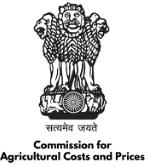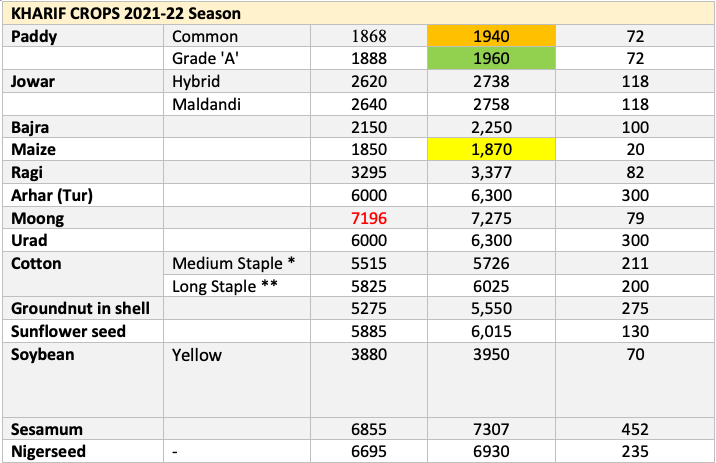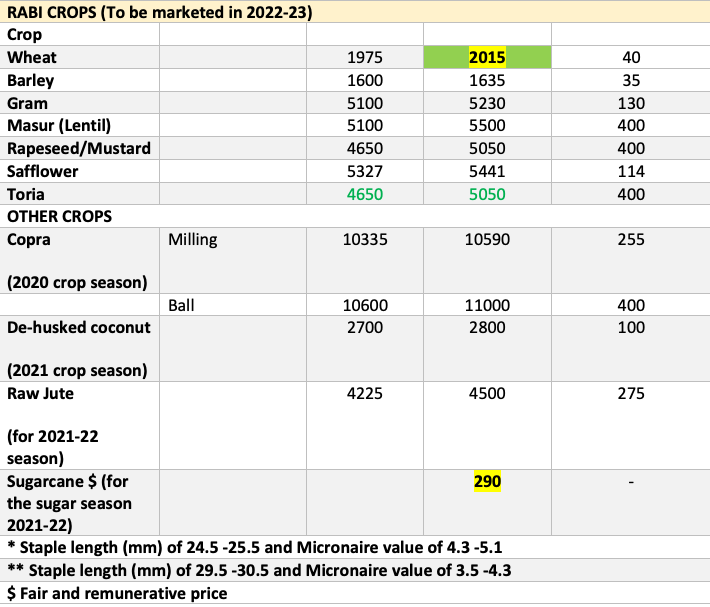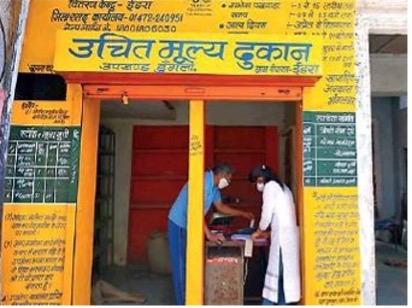₹ Pricing Policy
Learn about Agricultural Pricing Policy
Agriculture Price Policy

- It is a method of intervention in market mechanism through announcement of different administered prices viz. minimum support prices, procurement prices and issue prices.
- These prices are
announcedfor different agricultural crops by the Department of Agriculture and Co-operation, Government of India on therecommendationAFO-2021 of Commission for Agricultural Costs and Prices (CACP). - Now only MSP is announced by at the beginning of each sowing season by the Cabinet Committee of Economic Affairs (CCEA) based on the recommendations of the Commission for Agricultural Costs and Prices (CACP).
CACP
- The Commission was originally set up in
1965in the name of the Agricultural Price Commission (APC) on the recommendations of the Food grains Prices Committee headed by Shri. L. K. Jha with the aim of advising the government on price policy of agricultural commodities with due regard to the interests of both consumers and producers. - It was renamed to Commission for Agricultural Cost and Price in
1985.
⭐️ CACP established in 1965
⭐️ CACP name was given in 1985
- Current chairman of CACP is
Dr. Vijay Paul Sharma. - The CACP is an attached office of the Ministry of Agriculture and Farmers Welfare, formed in
1965. It is a statutory body that submits separate reports recommending prices for Kharif and Rabi seasons.
Administered Prices
- Prices fixed by the government with the objective of protecting farmers against a decline in prices during the year of bumper production, protecting consumers from excessive price increases and ensuring procurement for buffer stocks or operation of PDS. These are three types:
1. Minimum Support Price, (MSP)
- Price fixed by the government to protect farmers against excessive fall in prices during bumper production year.
- It is announced in the month of June and October (twice in a year) before the sowing of Kharif & Rabi Crops so that the farmers can take a considered view on sowing these crops.
- Reason behind the idea of MSP is to counter price volatility of agricultural commodities due to the factors like variation in their supply, lack of market integration and information asymmetry.
Crops Covered
- Government announces minimum support prices (MSPs) for
22 mandated cropsandFair and Remunerative Price (FRP)for sugarcane. [Total 23] - The mandated crops are 14 crops of the kharif season, 6 rabi crops and two other commercial crops. In addition, the MSPs of toria and de-husked coconut are fixed on the basis of the MSPs of rapeseed/mustard and copra, respectively. The list of crops are as follows.
- Cereals (7) - paddy, wheat, barley, jowar, bajra, maize and ragi
- Pulses (5) - gram, arhar/tur, moong, urad and lentil
- Oilseeds (8) - groundnut, rapeseed/mustard, toria, soyabean, sunflower seed, sesamum, safflower seed and nigerseed
- Raw cotton
- Raw jute
- Copra
- De-husked coconut
- Sugarcane (Fair and remunerative price)
- Virginia flu cured (VFC) tobacco
Procurement Agency
- The Food Corporation of India (FCI), the nodal central agency of the Government of India, along with other State Agencies undertakes procurement of crops.

Kharif 2021-22 Marketing Season
- This MSP policy whereby the farmers are assured of a minimum of 50 percent as margin of profit is one of the important and progressive steps towards doubling farmers’ income by 2022 and improving their welfare substantively.
- The increase in MSP for Kharif Crops for marketing season 2021-22 is in line with the Union Budget
2018-19announcement of fixing the MSPs at a level ofat least 1.5 timesof the All-India weightedaverage Cost of Production (CoP), aiming at reasonably fair remuneration for the farmers. - Calculated at
A2 + FL Method. - Concerted efforts were made over the last few years to realign the MSPs in favour of oilseeds, pulses and coarse cereals to encourage farmers shift to larger area under these crops and adopt best technologies and farm practices, to correct demand — supply imbalance.
- The highest absolute increase in MSP over the previous year has been recommended for sesamum (Rs. 452 per quintal) followed by tur and urad (Rs. 300 per quintal each).
- In case of groundnut and nigerseed, there has been an increase of Rs 275 per quintal and Rs 235 per quintal respectively in comparison to last year. The differential remuneration is aimed at encouraging crop diversification.
- The expected returns to farmers over their cost of production are estimated to be highest in case of Bajra (85%) followed by urad (65%) and tur (62%). For rest of the crops, return to farmers over their cost of production is estimated to be at least 50%.
- Besides, the Umbrella Scheme “Pradhan Mantri Annadata Aay SanraksHan Abhiyan” (PM-ASHA) announced by the government in
2018will aid in providing remunerative return to farmers for their produce. The Umbrella Scheme consists of three sub-schemes i.e. Price Support Scheme (PSS), Price Deficiency Payment Scheme (PDPS) and Private Procurement & Stockist Scheme (PPSS) on a pilot basis. - With an aim to attain self-sufficiency in the production of pulses, a special Kharif strategy has been prepared for implementation in the ensuing Kharif 2021 season. A detailed plan for both area expansion and productivity enhancement for Tur, Moong, and Urad has been formulated.
- Under the strategy, all the available high-yielding varieties (HYVs) of seeds will be distributed free of cost to increase area through intercropping and sole crop. Similarly, for Oilseeds, the Government of India has approved an ambitious plan for the free distribution of high-yielding varieties of seeds to the farmers for the Kharif season 2021 in the form of mini-kits.

Rabi 2022-23 Marketing Season
- The highest absolute increase in MSP over the previous year has been recommended for Lentil (Masur) and Rapeseeds & Mustard (Rs.400 per quintal each) followed by gram (Rs.130 per quintal).
- In case of safflower, there has been an increase of Rs.114 per quintal, in comparison to last year.
- The differential remuneration is aimed at encouraging crop diversification.
- The expected returns to farmers over their cost of production are estimated to be highest in case of wheat and rapeseed & mustard (100% each), followed by lentil (79%); gram (74%); barley (60%); safflower (50%).

- The Fair and Remunerative Price (FRP) of
sugarcanepayable by sugar mills for 2021-22 sugar season (October-September) is as follows:- FRP of sugarcane for 2021-22 sugar season at Rs.290/- per quintal for a basic recovery rate of 10%
- Premium of Rs. 2.90 per quintal for every 0.1 % increase above 10 % in the recovery and reduction in FRP by Rs. 2.90 per quintal for every 0.1 percentage point decrease in recovery
- No deduction in case of sugar mills where recovery is below 9.5%. Such farmers will get Rs. 275.50 per quintal for sugarcane in ensuing sugar season 2021-22.
Fixation of MSP
- Factors taken into consideration for fixing MSP include:
- Demand and supply
- Cost of production (A2 + FL method)
- Price trends in the market, both domestic and international
- Inter-crop price parity
- Terms of trade between agriculture and non-agriculture
- A minimum of 50% as the margin over cost of production
- Likely implications of MSP on consumers of that product
- The Commission also makes visits to states for on-the-spot assessment of the various constraints that farmers face in marketing their produce, or even raising the productivity levels of their crops.
- Based on all these inputs, the Commission then finalizes its recommendations/reports, which are then submitted to the government.
- The government, in turn, circulates the CACP reports to state governments and concerned Central Ministries for their comments.
- After receiving the feed-back from them, the Cabinet Committee on Economic Affairs (CCEA) of the Union government takes a final decision on the level of MSPs and other recommendations made by the CACP.
Problems with MSP
- The MS Swaminathan Commission, which is often cited by farmers seeking better prices for their produce, had recommended that the MSP should be 50 percent higher than the total cost of production.
- Broadly, there are three methods of calculating MSP A2, A2 + FL and C2.
- The A2 method includes only the actual paid-out costs that the farmer, while the A2 + FL method includes the paid-out costs as well as the imputed cost of family labour that goes into producing the crops. C2 includes paid-out costs, imputed family labour as well as imputed rent and interest on land and other capital assets. As is evident, the C2 method would ensure the highest price for the farmer
- The government presently calculates the minimum support prices based on the
A2 + FL method. The Swaminathan Commission had, however, stated that the MSP should be based on the comprehensive cost of production, which is the C2 method.
Rationale
- The rationale behind the Minimum Support Price (MSP) operations is to provide guaranteed price and assured market to the farmers and protect them from the price fluctuations and market imperfections.
- The guaranteed price and assured market meant to encourage higher investment and in adoption of modern farming practices.
- The Commission for Agricultural Costs and Prices (CACP), a body under the Ministry of Agriculture and Farmers Welfare, is mandated to recommend minimum support prices (MSPs) to incentivize the cultivators to adopt modern technology, and raise productivity and overall grain production in response to rising demand pattern in the country. In a bid to meet such an objective, MSP for major agricultural products is announced by the government annually after taking into consideration the recommendation of CACP.
- CACP recommends MSPs of 23 commodities, which comprise of seven cereals (paddy, wheat, maize, sorghum, pearl millet, barley and ragi), five pulses (gram, tur, moong, urad, lentil), seven oilseeds (groundnut, rapeseed-mustard, soyabean, seasum, sunflower, safflower, niger seed), and four commercial crops (copra, sugarcane, cotton and raw jute).
- The commission submits its recommendation to the government in the form of annual Price Policy Reports published separately for five groups of commodities — Kharif crops, Rabi crops, Sugarcane, Raw Jute and Copra.
- Prior to the preparation of five pricing policy reports, the Commission prepares a comprehensive questionnaire, and sends to all it the state governments and concerned National organizations and Ministries for soliciting their comments and views. Subsequently, separate meetings are also held with farmers from various states, organizations such as Food Corporation of India (FCI), National Agricultural Cooperative Marketing Federation (NAFED), Cotton Corporation of India (CCI), Jute Corporation of India, trader’s organizations and associated ministries. The officials from CACP also visit states for on-the-spot assessment farmers face in marketing their produce, or even raising the productivity levels of their crops.
- Based on all these inputs, the Commission then finalises its recommendations/reports, which are then submitted to the government. Subsequently, the government, circulates the CACP reports to state governments and concerned central Ministries for their comments. After receiving the feedback from them, the Cabinet Committee on Economic Affairs (CCEA) takes a final decision on the level of MSPs and other recommendations made by CACP.
- The key points CACP takes into accounts before recommending MSP for a commodity to the government include demand and supply cost of production, price trends in the market, both domestic and International, inter-crop price parity, terms of trade between agriculture and non-agriculture; a minimum of 50 percent as the margin over cost of production, and likely implications of MSP on consumers.
- The Economic Survey of 2021-22 has also addressed the issue of rising bill of food subsidy in the country. FCI’s economic cost of rice is Rs. 37/kg and of wheat about Rs. 27/kg and it is difficult to bring down the economic cost of food due to food security commitments. Hence, the Survey suggested need to consider a revision of the central issue price (CIP). The CIP of wheat, rice and coarse grains under NFSA, Mid-Day Meal Scheme, and Integrated Child Development Services (ICDS) are fixed rate of Rs. 3, 2 and 1 per kg respectively. This has remained unchanged since the introduction of
NFSA 2013. - CIP: Central issue price is the price at which the government makes available foodgrains for beneficiaries of the National Food Security Act, 2013 and other welfare schemes to the states from the central pool.
2. Procurement Price
- Refers to the price at which
government procures from producersto maintain buffer stocks and feed Public Distribution System (PDS). - Procurement prices were the prices of Kharif and Rabi cereals at which the grain was to be domestically procured by public agencies (like the FCI) for release through PDS.
- It was announced soon after harvest began.
- Normally procurement price was lower than the open market price and
higher than the MSP. - Beginning with Kharif crops 1991-92, the system of announcement of procurement prices has been
abolishedand only minimum support price is announced.
3. Issue Price

- Price at which the commodity is made available to consumers at fair price shops.
- It is always lower than procurement price.
⭐️ Market Price > Procurement Price > MSP > Issue Price
Characteristics of Agricultural product prices
👉🏻 In agriculturally based economies like India, prices of farm products undergo wide variations than in industrial goods. They have profound effect on the economy. The characteristics of agricultural product prices are presented below to design appropriate price policy.
- Production and supply of agricultural products cannot be adjusted quickly to changes in prices or demand.
- Variability in cost of production from region to region.
- Wide variation in quality of products and hence prices.
- The prices of farm products in general exhibit co-movement at least within a group.
- The prices of farm products vary across space.
- The prices of farm products in general remain low in the post-harvest period.
- There are multiple prices in the same market at a point of time.
- Regulated market must ensure fair price (A good price that is acceptable to both the buyer and the seller, often one that reflects the current market value).
Market Intervention Scheme (MIS)
- MIS is an adhoc scheme of price support. The scheme covers horticultural and other commodities which are perishable in nature and are not covered under minimum support price scheme.
- Objective: It provides remunerative prices to the farmers in case of glut in production and fall in prices.
- Criteria: The Scheme is implemented when there is at least 10% increase in production or 10% decrease in the ruling rates over the previous normal year.
- Department: Department of Agriculture & Cooperation
- Funding Mechanism: The MIS is implemented on the specific requests of the State Government/UT Administrations willing to share the loss with Central Government on 50 : 50 basis (75:25 in case of North-Eastern States).
- Action Taken: A pre-determined quantity at a fixed Market Intervention Price (MIP) is procured by NAFED as the Central agency and the agencies designated by the state government for a fixed period or till the prices are stabilized above the MIP whichever is earlier.
Integrated Scheme for Agricultural Marketing (ISAM)
- Started in
2014. AFO 2018 - The Government has launched this scheme to keep in pace with the growing production and marketing surplus.
Objectives
- To promote the creation of agricultural marketing infrastructure by providing backend subsidy support to State, cooperative and private sector investments.
- To promote creation of scientific storage capacity and to promote pledge financing to increase farmers’ income.
- To promote Integrated Value Chains (confined up to the stage of primary processing only) to provide vertical integration of farmers with primary processors.
- To use ICT as a vehicle of extension to sensitize and orient farmers to respond to new challenges in agricultural marketing.
- To establish a nation-wide information network system for speedy collection and dissemination of market information and data on arrivals and prices for its efficient and timely utilization by farmers and other stakeholders.
- To support the framing of grade standards and quality certification of agricultural commodities to help farmers get better and remunerative prices for their graded produce.
- To catalyze private investment in setting up of agribusiness projects and thereby provide an assured market to producers and strengthen backward linkages of agribusiness projects with producers and their groups.
- To undertake and promote training, research, education, extension and consultancy in the Agri marketing sector.
Sub-schemes
👉🏻 Following are the five sub-schemes of ISAM:
1. Agricultural Marketing Infrastructure (AMI)
- AMI scheme is a back ended capital subsidy scheme in which rate of subsidy is
25 %and33.33 %based on the category of eligible beneficiary and is provided on capital cost of the project. - For the creation of Agricultural Marketing Infrastructure, Grameen Bhandaran Yojana (GBY) along with Scheme for Development/ Strengthening of Agricultural Marketing Infrastructure, Grading and Standardisation (AMIGS) are coordination. Under the Integrated Scheme for Agriculture Marketing, these two schemes are subsumed into one subscheme known as Agricultural Marketing Infrastructure.
- Eligible Organizations: The project for construction of rural godowns can be taken up by individuals, farmers, Group of farmers/growers, Partnership/ Proprietary firms, Non-Government Organizations (NGO’s), Self Help Groups (SHGs), Companies, Corporations, Co-operatives, Local Bodies other than Municipal Corporations, Federations, Agricultural Produce Marketing Committees, Marketing Boards and Agro Processing Corporations in the entire country.
- Assistance for renovation of rural godowns will, however, be restricted to godowns constructed by cooperatives only.
2. Marketing Research and Information Network
- The availability and dissemination of complete and accurate marketing information is the primary requirement for operational and pricing efficiency in the marketing system. In order to completely utilise the new emerging marketing opportunities for the benefit of the farming community, Agricultural Marketing Information Network is being established.
3. Strengthening of Agmark Grading Facilities
- SAGF aims to help the Directorate of Marketing & Inspection (DMI) to implement the Agricultural Produce Act 1937 including the meeting expenditure for the purchase of equipment, renovation and repair works in the Agmark laboratories/ Regional and Sub-offices of DMI.
4. ABD through VCA and PDF
- Agribusiness Development (ABD) through Venture Capital Assistance (VCA) and Project Development Facility (PDF) facilitates in setting up of agribusiness ventures in association with every Financial Institutions that are notified by the Reserve Bank of India, where the ownership of the Central/ State Government is more than 50%. The financial institutions include nationalised banks, SBI and its subsidiaries, IDBI, SIDBI, NABARD, NCDC, NEDFi, Exim Bank, RRB and State Financial Corporation.
5. CCS NIAM, Jaipur
- The institution undertakes and promotes the study of applied and operational research in problem areas of agricultural marketing and to serve as a national level nodal point for co-ordination of several research studies and dissemination of technologies that are relevant to agricultural marketing across the nation.
e-NAM
- Electronic - National Agricultural Market or e-NAM is a Pan India, unified national electronic agriculture market for agricultural commodities. It was launched by
Ministry of Agricultureon 14th April,2016to facilitate farmers, traders, buyers, exporters and processors with a common platform for trading commodities. - In this innovative market process is revolutionizing agri-markets by ensuring better price discovery, bringing in transparency and competition to enable farmers to get improved remuneration for their produce moving towards ‘One Nation One Market’ with the aim to integrate regulated markets with the common e-market platform.
- SFAC is the implanting agency for eNAM.
- It facilitates online trading in more than 150 commodities with digital payment option.
Agriculture Price Policy

- It is a method of intervention in market mechanism through announcement of different administered prices viz. minimum support prices, procurement prices and issue prices.
- These prices are
announcedfor different agricultural crops by the Department of Agriculture and Co-operation, Government of India on therecommendationAFO-2021 of Commission for Agricultural Costs and Prices (CACP). - Now only MSP is announced by at the beginning of each sowing season by the Cabinet Committee of Economic Affairs (CCEA) based on the recommendations of the Commission for Agricultural Costs and Prices (CACP).
CACP
- The Commission was originally set up in
1965in the name of the Agricultural Price Commission (APC) on the recommendations of the Food grains Prices Committee headed …
Become Successful With AgriDots
Learn the essential skills for getting a seat in the Exam with
🦄 You are a pro member!
Only use this page if purchasing a gift or enterprise account
Plan
Rs
- Unlimited access to PRO courses
- Quizzes with hand-picked meme prizes
- Invite to private Discord chat
- Free Sticker emailed
Lifetime
Rs
1,499
once
- All PRO-tier benefits
- Single payment, lifetime access
- 4,200 bonus xp points
- Next Level
T-shirt shipped worldwide

Yo! You just found a 20% discount using 👉 EASTEREGG

High-quality fitted cotton shirt produced by Next Level Apparel